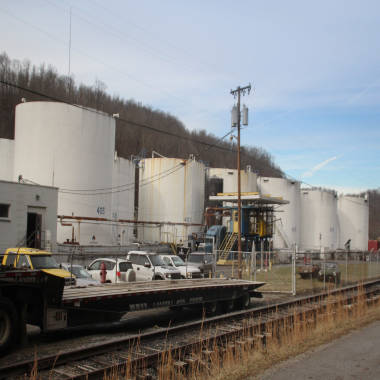
The Freedom Industries chemical plant is shown after a leak at the facility sent chemicals into the Elk River near Charleston, West Virginia Jan. 10, 2014.
Lisa Hechesky / Reuters News
via NBC link belowAccording to a source ...
"I live in Charleston and have some more information. Not much is known about the chemical (other than LD50) since it is not regulated. Apparently the LD50 is that 825 mg ingested per 1 kg weight of a rat. this puts it in the mild to moderately toxic category, BUT is is not known if it is carcinogenic since it’s never been tested. The recommended safe level for drinking water is a guess, I assume based on similar chemicals.
The water company’s intake was about a mile downstream from the plant. When the water company was initially told about the leak, they were given the wrong chemical name, a chemical that could be treated by just beefing up their regular treatment. It wasn’t until the chemical was in the system did they realize that the treated water was contaminated. It was another hour or two before the warning was sent out to the public."
FYI - LD50 means lethal dose to 50% of the test population.
From NBC News http://usnews.nbcnews.com/_news/2014/01/13/22293313-west-virginia-chemical-company-facing-tough-questions-after-spill
But as the logistics are sorted out, tough questions to understand how the water became poisoned — and whether the chemical company responsible for the leak, Freedom Industries, broke the law on how long it took to report its chemical spill in the Elk River — must be adequately answered, lawmakers and activists told NBC News.
Residents first reported a licorice-type odor in their water at 8:15 a.m. ET Thursday, state officials said. But Freedom didn’t report the spill until 12:05 p.m. — nearly an hour after the state Department of Environmental Protection had already traced it to one of their leaking tanks.
...
"We want to know why (the response from Freedom) took so long. The inaction is an indictment to the idea that companies can self-report and self-regulate,” said State Delegate Stephen Skinner, a Democratic member of the House Judiciary Committee. “I absolutely see some legislation coming out of all this."
The heart of the investigation will likely focus on potential loopholes in current laws: Freedom, because the chemicals it stores aren't considered especially "hazardous," may not have had to follow a state law requiring industrial facilities to report an emergency within 15 minutes.
And the DEP never inspected the facility because it was essentially considered a storage shed, and didn't actually produce chemicals, officials said.
"It flew under the radar," said Randy Huffman, cabinet secretary of the state DEP.
Freedom’s storage terminal near the Elk River holds millions of pounds of chemicals — including some used in coal processing — just a mile and a half upstream from pipes that take in water for a public drinking supply. The distance left little opportunity for chemicals to dilute in the event of a spill.
...
Experts say the chemicals found on the Freedom site are common to many industrial operations and not considered extremely hazardous, though they are harmful if swallowed and can cause skin and eye irritation. They can be used to prevent dust buildups or treat drinking water, or they can be used in personal cosmetics.
...
The chemicals at the property included up to 1 million pounds of MCHM, which is used to separate bits of rocks and clay from mined coal. Somehow, the leaking tank suffered a 1-inch hole in its bottom, allowing the chemical to pool on the ground and go through a dike, contaminating the river.
“There are questions the public still needs to know: How long was the chemical leaking? And what will be the repercussions against the company for not reporting sooner?” asked Vivian Stockman, spokeswoman for the Ohio Valley Environmental Coalition.
...
And the Ohio River Valley Water Sanitation Commission said Monday it was monitoring the movement of the Elk River spill, which has flowed into the Ohio River. Cincinnati moved to shut off its water intake from the Ohio as a precaution while the chemical-tainted water moved through.
From National Geographic http://news.nationalgeographic.com/news/2014/01/140110-4-methylcyclohexane-methanol-chemical-spill-west-virginia-science/
Understanding 4-Methylcyclohexane Methanol
A consultant at a major mining industry firm told National
Geographic that 4-methylcyclohexane methanol is used at about 20 to 25
percent of coal processing plants in West Virginia.
The consultant, a former miner who insisted on anonymity
because of orders from his employer, said the chemical is used in a
process called froth flotation, which separates sand-size particles of
coal from the surrounding rock, in a tank of water or another solution.
Not every coal preparation plant uses this chemical, because it is
primarily used to produce coal for metallurgical purposes, called coking
coal, the consultant said. The chemical is rarely used to produce coal
that is burned to create electricity, called steam coal, which
represents the vast majority of coal produced.
"Thirty years ago I used diesel fuel in froth flotation,
but you can't use that anymore because of restrictions on air
emissions," the consultant said.
The chemical 4-methylcyclohexane methanol replaced diesel.
No comments:
Post a Comment
Hi! I do read all of the comments and want to let you know that I really appreciate your stopping by and taking the time to leave a note. Work has fallen in on me and I have not had enough time to reply coherently lately so I apologize preemptively but still want to assure you that your comments are valued. I am using comment moderation to avoid using more annoying spam avoidance. Thanks for your patience.